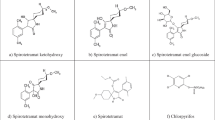Abstract
Quinalphos 20 AF was applied at the rate of 500 and 1,000 g a.i. ha − 1 in cabbage for two consecutive seasons and the samples harvested at intervals of 0 (3 h after application), 2, 4, 6, 8, and 10 days interval after application. The calculated half-life values were 1.27–1.38 days and 1.12–1.24 days for cabbage heads and cropped soil, respectively. The calculated safe waiting period based on field dissipation study was 5.28–6.7 days, which indicated its persistence nature. Thus, to reduce the safe waiting period, efforts were made to decontaminate the Quinalphos residue from cabbage head by various household preparations (viz. washing, cooking, washing plus cooking, salt water dipping, dipping in boiled salt water, dipping in detergent solution, and dipping in boiled detergent solution). Statistical analysis of the data using Duncan’s multiple range test revealed that various household processing substantially reduced the residue of Quinalphos in cabbage heads in the range of 27.72–75.01% irrespective of any dose and seasons, but none were able to satisfactorily bring down the residue below the tolerance level of 0.05 mg kg − 1.
Similar content being viewed by others
References
Awasthi, M. D., Anand, L., Moorthy, P. N. K., & Sarode, S. V. (1984). Movement and distribution pattern of the residue of granular insecticides in tropical soil and okra plants. Plant and Soil, 81(3), 445–449. doi:10.1007/BF02323060.
Awata, B. G., Dwlya, V. P., & Rajput, K. G. (1984). Field evaluation of some newer insecticide for the control of Jassids (Amrasca bigutulla bigutulla Ishida) on Bhendi. Pestology, 8(7), 14–15.
Banerjee, K., Upadhyay, A. K., Adsule, P., Pandurang, G., Patil, S. H., OulKar, D. P., et al. (2006). Rate of degradation of λ-cyhalothrin and methomyl in grapes (Vitis vinifera L.). Food Additives and Contaminants, 23(6), 994–999. doi:10.1080/02652030600838613.
Bhanti, M., & Taneia, A. (2007). Contamination of vegetables of different seasons with organophosphorous pesticides and related health risk assessment in northern India. Chemosphere, 69(1), 63–68. doi:10.1016/j.chemosphere.2007.04.071.
Dhiman, N., Jyot, G., & Bakhshi, A. K. (2006). Decontamination of various insecticides in cauliflower and tomato by different processing methods. Mysore Journal of Food Science and Technology, 43(1), 92–95.
Easwaramurthi, S., Dulliah, S., & Utuama, S. S. (1976). Efficacy of certain insecticides against the sucking pest of Bhendi (Abelmoschus esculentus). Madras Agricultural Journal, 63(4), 254–256.
Jacob, S., & Verma, S. (1989). Persistence and decontamination of malathion on Cabbage. Indian Journal of Entomology, 51(4), 377–383.
Jacob, S., & Verma, S. (1991). Decontamination of Cabbage treated with quinalphos. Indian Journal of Entomology, 53(2), 286–290.
Karanth, N. G. K. (2002). Challenges of limiting pesticide residues in fresh vegetables. The Indian experience. In food safety management in developing countries. In Proceedings of the international workshop, CIRAD-FAO, 11–3 December 2000.
Kidd, H., & James, D.R. (Eds.) (1991). The agrochemicals handbook (3rd ed., pp. 5–14). Cambridge, UK: Royal Society of Chemistry Information Services.
Kole, R. K., Banerjee, H., & Bhattacharyya, A. (2000). Occurrence of pesticide residues in farmgate vegetable samples in west Bengal. Pesticide Research Journal, 14(1), 77–82.
Krol, W. J., Arsenault, T. L., Pylypiw, H. M., & Mattina, M. J. I. (2000). Reduction of pesticide residues on produce by rinsing. Journal of Agricultural and Food Chemistry, 48(10), 4666–4670. doi:10.1021/jf0002894.
Kumari, B., Madan, V. K., & Singh, J. (2004). Monitoring of pesticidal contamination of farmgate vegetables from Hisar. Environmental Monitoring and Assessment, 90(1–3), 65–71. doi:10.1023/B:EMAS.0000003566.63111.f6.
Nagesh, M., & Verma, S. (1997). Decontamination of cabbage treated with chlorpyriphos and quinalphos. Indian Journal of Entomology, 59(4), 404–410.
Patel, B. A., Shah, M. F., Patel, B. K., Patel, J. L., & Talati, J. G. (1999). Chlorpyriphos residues in/on cabbage and brinjal. Pesticide Research Journal, 11(2), 194–196.
Ramesh, A., Balasubramanian, M., Ramesh, A., & Balasubramanian, M. (1999). The impact of household preparation in the residues of pesticides in selected agricultural commodities available in India. Journal of AOAC International, 82(3), 725–737.
Regupathy, A., Habcebullah, B., & Balasubramanian, M. (1985). Dissipation of insecticides applied to control Plutella xyllostella citrus and spodoptera litura, faber in cabbage. Pesticides, 19(9), 53–56.
Rengasamy, S. & Dureja, P. (2001). Pesticides handbook, society of pesticide science India, division of agricultural chemicals (Vol. 110012, pp. 38–39). New Delhi: Indian Agricultural Research Institute.
Smith, G. N. (1968). Ultraviolet light decomposition studies with dursban and 3,5,6- trichloro-2- pyridinol. Journal of Economic Entomology, 61(3), 793–795.
Zabik, M. J., El-Hadidi, M. F. A., Cash, J. N., Zabik, M. E., & Jones, A. L. (2000). Reduction of Azinophos- methyl, chlorpyriphos, esfenvalerate, and methomyl residues in processed apples. Journal of Agriculture and Food Chemistry, 48, 4199–4203. doi:10.1021/jf9913559.
Author information
Authors and Affiliations
Corresponding author
Rights and permissions
About this article
Cite this article
Aktar, M.W., Sengupta, D., Purkait, S. et al. Risk assessment and decontamination of Quinalphos under different culinary processes in/on cabbage. Environ Monit Assess 163, 369–377 (2010). https://doi.org/10.1007/s10661-009-0841-9
Received:
Accepted:
Published:
Issue Date:
DOI: https://doi.org/10.1007/s10661-009-0841-9




